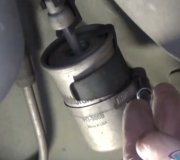Since you have been waiting for another reply, I will stick my nose in here. The type of sending unit circuit Steve is referring to was commonly used on GM vehicles. Those older mechanical gauges on all brands were very reliable, not like the computer-over-involved circuits we have today. GM's gauges used a "strong-coil / weak-coil design. The weak electromagnetic coil pulls the gauge's pointer fully to the right. The strong coil pulls the pointer to the left, but that coil has the sending unit in there too. When the fuel level is high, the float goes up, and the resistance of the sending unit is high, around 90 ohms. That much resistance means little current flows through the gauge's strong coil. It is too weak to overcome the weak coil, so the pointer goes toward "full".
As the fuel level drops, the resistance of the sending unit also goes down. The strong coil's strength increases and pulls the pointer down toward "empty".
With this design, if there is a break in the wire to the sending unit, a bad contact on the sending unit, or you disconnect the sending unit, the strong coil will be off completely, leaving just the weak coil to pull the pointer all the way to "full". If you were to ground the sending unit wire, the strong coil will be at its maximum strength, and will pull the pointer to "empty". There are two ways the pointer will act when the ignition switch is turned off. This type of gauge can be identified by the pointer staying right where it is, or it will suddenly pop to the left, when the ignition switch is turned off.
This GM design was not used by any other manufacturer that I am familiar with. The more common design used by Chrysler and Ford for many decades used a thermal heating element around a bimetallic strip that tugged on the pointer. The more it was heated, the more it would bend, and the more the pointer would move to the right. You can identify those by the pointer falling to the left very gradually when the ignition switch is turned off. Full travel can take as much as twenty to thirty seconds.
With the Chrysler/Ford system, if the sending unit wire is disconnected, no current will flow through the heating wire, and the pointer will relax and go to "empty". Grounding the wire will make the gauge go to the right. That is the opposite of GM gauges.
Regardless which type you have, the issue is the pointer should move fully one way when the sending unit wire is disconnected, and it should move the other way when it is grounded. That verifies the gauge and the wire are okay. A different way to check the circuit if the sending unit connector is hard to reach, is to disconnect the plug on the instrument cluster, then measure the resistance on the sending unit wire, to ground. If you get a reading of infinite, there is a break somewhere. For GM vehicles, the resistance will be near 90 ohms with a full tank, and progressively lower as the level in the tank goes lower. I have owned a real lot of Chrysler products, but never needed to test the fuel gauge circuit. The best I can say from memory is the resistance with an empty tank is quite low, possible less than 10 ohms, and it goes to 0 ohms as the fuel level goes up. I would have to measure a spare unit but there's no point since yours is likely to be different. The issue here is you're going to have something or nothing. A sending unit cannot change value, so it's going to be right unless it was replaced with the wrong part. Incorrect gauge operation is going to be caused by a break in the circuit, or the wire is grounded. Of course the float could be caught on something inside the tank, and that is making it read "full" all the time, but that is not likely to happen to a float that has been working fine for years. A sticking float is usually found after the sending unit and/or pump assembly were just replaced. One exception to this is there was a problem on Chevrolet Suburbans years ago where a baffle inside the tank would break free and block the float. There were no engine performance problems as long as you didn't run out of fuel, but the gauge did stay on "full".
Saturday, April 1st, 2017 AT 9:12 PM


